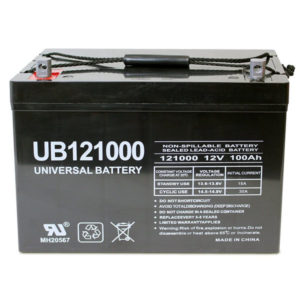All about AGM Batteries
You’ve probably read all sorts of advice on how to set up your 12V battery system in your van. Whether you’re setting up a solar-powered battery system, or charging it using your van’s alternator and an isolator– you’ll want a good battery that holds a charge. You’ll also want one that’s affordable, compact, and safe. That’s where an AGM battery shines. But what is a AGM battery? We’ll break down why an AGM is one of the best choices for using inside the confines of your new little “rolling home”.

What is an AGM Battery?
AGM stands for Absorbed Glass Mat, meaning a special glass pane is used to wick the battery electrolyte between the battery plates. This electrolyte solution causes a chemical reaction and produces electrons, which can then be used to power your accessories. While some other 12V batteries use liquids (“Wet-cell”) that need to be filled and maintained every so often, AGM batteries are considered to be maintenance-free, and cannot spill any harmful liquids.
Why AGM over other types?
When looking for a battery for your van or solar-powered setup, deep-cycle batteries are the most common choice. As opposed to a 12V starter battery (like what’s in the engine bay of your car), a deep-cycle battery is designed to be discharged in slow, irregular use, and can be depleted far further than a starter battery without damaging its integrity. At the same time, compared to a wet-cell or gel-cell deep cycle battery, an AGM battery can more capably deliver short bursts of high amps (i.e. power tools).
What is a AGM battery’s safety like? AGMs are among the safest deep-cycle 12V batteries on the market, and are ideal for enclosed areas. AGM batteries will not spill, leak, or emit any gasses into the surrounding space. They charge very fast compared to other lead-acid batteries, and hold up well in colder temperatures.

AGM battery maintenance
An AGM battery will be slightly costlier than other 12V batteries, as they cost more to manufacture. In our opinion, the peace of mind and low maintenance offsets this extra charge. We say low maintenance because you should be mindful of how low you discharge the battery– reducing it’s charge past 50% will quickly damage how many future charges the battery will hold. If you’re using a voltmeter and new to 12V batteries, you might think that 6 Volts is 50% charge, but this is INCORRECT. Your voltmeter should read between 12.6-13.0V on a full charge. Your 50% charge mark will be around 12.0 Volts, so to protect the life of your battery, be sure not to let it drop below this level.
What size AGM battery do I need?
If you haven’t calculated how many Amp Hours (ah) you need in your setup, it is wise to do so. Personally, we needed to charge our cell phones, laptop and camera batteries, and also had an inverter installed for a couple other accessories like an electric hair clipper. I didn’t want to have to worry too much about the charge level, even though we were going to be doing a lot of driving, so we chose a 100ah AGM battery, and never came close to the 50% mark.
You may opt for a larger battery if you’re looking to continuously power something, such as a 12V refrigerator. Or, you can scale down if you’re simply trying to power some LED lights at night and recharge your phone. Just keep in mind how often you plan to run the vehicle, assuming you’re connecting your AGM battery to the vehicles alternator. It took a good 45 min drive to bring our AGM battery back up to a full charge from the 50% mark.




